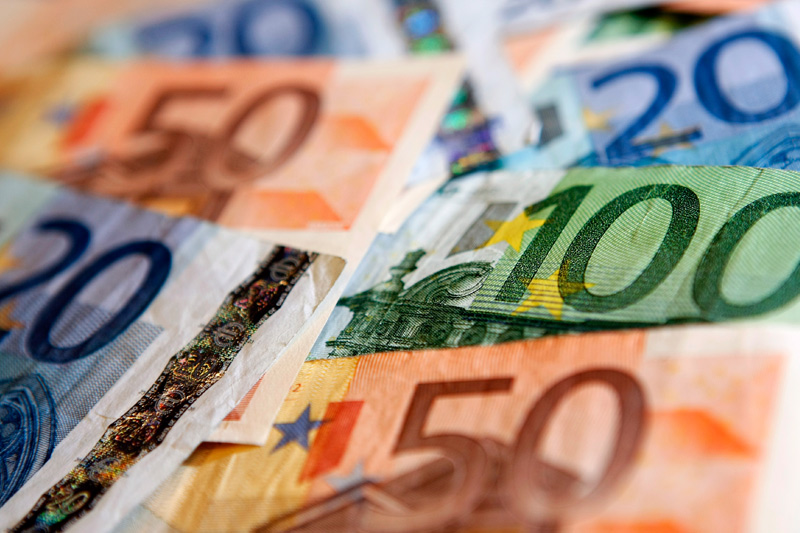Investing.com - The euro was mixed against its major counterparts on Thursday, falling against the U.S. dollar and the yen after weak euro zone data, but the single currency remained higher against the commodity linked currencies amid concerns over the outlook for growth in China.
During European late morning trade, the euro was lower against the U.S. dollar, with EUR/USD shedding 0.38% to hit 1.3165.
The euro weakened broadly after preliminary data showed that manufacturing activity in the euro zone slumped unexpectedly in March, remaining in contraction territory for the eighth consecutive month, sparking concerns that the region’s economy is sliding back into a recession.
Service sector activity in the euro zone declined to the lowest level in four months in March.
A separate report showed that industrial new orders in the euro zone dropped more-than-expected in January, falling 2.3% but the previous months figure was revised higher.
The shared currency was fractionally higher against the pound, with EUR/GBP inching up 0.04% to hit 0.8329.
In the U.K., official data showed that retail sales posted the largest drop in nine months in February and were revised down for the previous month.
The euro was sharply lower against the broadly stronger yen, with EUR/JPY slumping 1.13% to hit 108.99.
Government data showed earlier that Japan’s trade balance swung into a surplus of JPY32.92 billion in February, confounding expectations for a deficit of JPY120 billion following the downwardly revised deficit of JPY1.47 trillion reported in January.
The single currency was steady against the Swiss franc, with EUR/CHF inching up 0.01% to hit 1.2057.
The shared currency was broadly higher against the Canadian, Australian and New Zealand dollars, with EUR/CAD dipping 0.02% to hit 1.3111, EUR/AUD up 0.42% to hit 1.2687 and EUR/NZD gaining 0.46% to hit 1.6279.
Sentiment on the growth linked dollars was hit after a report showed that China’s HSBC manufacturing index contracted for a fifth successive month in March, as new orders fell.
Also Thursday, official data showed that New Zealand’s gross domestic product rose less-than-expected in the fourth quarter, rising 0.3% after a 0.7% increase the previous quarter.
Analysts had expected the GDP to rise 0.6% in the fourth quarter.
Later in the day, the U.S. was to publish official data on initial jobless claims, while European Central Bank President Mario Draghi and Federal Reserve Chairman Ben Bernanke were to speak at public engagements.
During European late morning trade, the euro was lower against the U.S. dollar, with EUR/USD shedding 0.38% to hit 1.3165.
The euro weakened broadly after preliminary data showed that manufacturing activity in the euro zone slumped unexpectedly in March, remaining in contraction territory for the eighth consecutive month, sparking concerns that the region’s economy is sliding back into a recession.
Service sector activity in the euro zone declined to the lowest level in four months in March.
A separate report showed that industrial new orders in the euro zone dropped more-than-expected in January, falling 2.3% but the previous months figure was revised higher.
The shared currency was fractionally higher against the pound, with EUR/GBP inching up 0.04% to hit 0.8329.
In the U.K., official data showed that retail sales posted the largest drop in nine months in February and were revised down for the previous month.
The euro was sharply lower against the broadly stronger yen, with EUR/JPY slumping 1.13% to hit 108.99.
Government data showed earlier that Japan’s trade balance swung into a surplus of JPY32.92 billion in February, confounding expectations for a deficit of JPY120 billion following the downwardly revised deficit of JPY1.47 trillion reported in January.
The single currency was steady against the Swiss franc, with EUR/CHF inching up 0.01% to hit 1.2057.
The shared currency was broadly higher against the Canadian, Australian and New Zealand dollars, with EUR/CAD dipping 0.02% to hit 1.3111, EUR/AUD up 0.42% to hit 1.2687 and EUR/NZD gaining 0.46% to hit 1.6279.
Sentiment on the growth linked dollars was hit after a report showed that China’s HSBC manufacturing index contracted for a fifth successive month in March, as new orders fell.
Also Thursday, official data showed that New Zealand’s gross domestic product rose less-than-expected in the fourth quarter, rising 0.3% after a 0.7% increase the previous quarter.
Analysts had expected the GDP to rise 0.6% in the fourth quarter.
Later in the day, the U.S. was to publish official data on initial jobless claims, while European Central Bank President Mario Draghi and Federal Reserve Chairman Ben Bernanke were to speak at public engagements.
